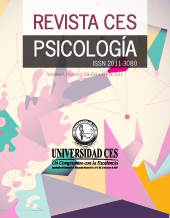Predictive Psychosocial Variables of Non-Adherence to Antiretrovirals in People with HIV-AIDS
DOI:
https://doi.org/10.21615/cesp.12.3.5Keywords:
Psychosocial Variables, Adherence, Antiretroviral Treatment, Antiretroviral Drugs, HIV/AIDSAbstract
Objective: Objective: The main aim of this study was to evaluate the levels of adherence to antiretrovirals treatment as well as to determine the psychological factors that predict the non-adherence to antiretrovirals in HIV patients who attend a civil association in Guadalajara, México. Method: It was a descriptive, transversal and correlational design. The sample consisted of 25 patients diagnosed with HIV who attended integral services of a Civil Association. The Adherence to Treatment for HIV/AIDS Questionnaire [CAT-HIV] and the Questionnaire of Factors Related to Adherence to Treatment for HIV/AIDS (CFR-AT HIV) were used. Descriptive and nonparametric analyzes were carried out to compare the study variables, as well as their respective correlations, all through the statistical program SPSS v.20. Results: Only 60% of those evaluated showed adequate adherence to antiretrovirals; in addition, significance differences between adherents and non-adherents in the self-efficacy variable (Z = -3.196, p = .001); stress (Z = -2.033, p = .042); and depression (Z = -2.409, p = .016). Positive correlations of adherence were obtained with self-efficacy (r = .750, p = .000) and social support (r = .462, p = .020) and negative correlations with stress (r = - .543; p = .005) and depression (r = -. 544; p = .005). Conclusions: The higher levels of stress and depression, the lower the levels of adherence to antiretroviral treatment; therefore, these variables must be considered in the design of strategies to improve adherence in people with HIV.
Downloads
References
Alvis, O., De Coll, L., Chumbimune, L., Díaz, C., Díaz, J., & Reyes, M. (2009). Factores Asociados a la no adherencia al tratamiento antirretroviral de gran actividad en adultos infectados con el VIH SIDA. An Fac Med. 70(4), 266-272. Recuperado de: http://www.scielo.org.pe/pdf/afm/v70n4/a07v70n4.pdf
Amigo I., Fernández, C., & Pérez, M. (2008). Manual de Psicología de la salud. Madrid: Pirámide Ed.
Benavides, M. (2017). Adherencia al tratamiento y autoeficacia en hombres con VIH/SIDA de la ciudad de Cali. Tesis de Grado No Publicada. Universidad de Cali. Colombia. Recuperado de: http://vitela.javerianacali.edu.co/bitstream/handle/11522/8602/Adherencia_tratamiento_autoeficiencia.pdf?sequence=1&isAllowed=y
Brandt, C., Zvolensky, M.J., Woods, S.P., Gonzalez, A., Safren, S.A., & O’Cleirigh, C.M. (2017). Anxiety symptoms and disorders among adults living with HIV and AIDS: a critical review and integrative synthesis of the empirical literature. Clin Psychol Rev., 51, 64-84. doi: http://dx.doi.org/10.1016/j.cpr.2016.11.005.
Centro Nacional para la Prevención del VIH/SIDA -CENSIDA-. (2018). Vigilancia Epidemiológica de casos de VIH/SIDA en México. Registro Nacional de Casos de SIDA. Actualizado al 9 de noviembre de 2018. Recuperado de: https://www.gob.mx/cms/uploads/attachment/file/415154/RN_D_a_mudial_sida2018.pdf
Codina, C., Martínez, M., Tuset, M., Del Cacho, E., Martín, M.T., Miró, J.M., …Ribas, J. (2002). Comparación de tres métodos de cálculo de adherencia en pacientes con tratamiento antirretroviral. Enferm Infecc Microbiol Clin., 20(10), 484-90.
Demirel O.F., Mayda, P.Y., Nazim, Y., Saglam, H., Kocak, B., Habip, Z., … Kocazeybek, B. (2018). Self-stigma, depression, and anxiety levels of people living with HIV in Turkey. Eur. J. Psychiat. 32(4), 159-196.
Ezeamama, A.E., Woolfork, M.N., Guwatudde, D., Bagenda, D., Manabe, Y.C., & Smith, M. (2016). Depressive and anxiety symptoms predict sustained quality of life deficits in HIV-positive Ugandan adults despite antiretroviral therapy: a prospective cohort study. Medicine (Baltimore), 95(9), e2525. doi: http://dx.doi.org/10.1097/MD.0000000000002525
González, J. S., Batchelder, A.W., Psaros, C., & Safren, S.A. (2011). Depression and HIV/AIDS treatment nonadherence. A review and meta-analysis. J Acquir Immune Defic Syndr. 58(2), 1-13. doi: hhtp://dx.doi.org/10.1097/QAI.0b013e31822d490a
Guerra, L., & Parras, F. (2000). La adherencia a los antirretrovirales: una tarea de todos. Enf Emerg. 2(1), 5-9. Recuperado de: http://enfermedadesemergentes.com/articulos/a58/s-2-1-001.pdf
Hernández, R., Fernández, C., & Baptista M. (2010). Metodología de la Investigación. México: McGraw Hill.
Holguín, L., Correa, D., Arrivillaga, M., Cárceres, D., & Varela, M. (2006). Adherencia al tratamiento de hipertensión arterial: efectividad de un programa de intervención biopsicosocial. Univ. Psychol., 5(3), 535-547. Recuperado de: http://www.scielo.org.co/pdf/rups/v5n3/v5n3a09.pdf
Holtzman, C.W., Brady, K.A., & Yehia, B.R. (2015). Retention in care and medication adherence: Current challenges to antiretroviral therapy success. Drugs., 75(5), 445–54.
Ichikawa, M., & Natpratan, C. (2006). Perceived social environment and quality of life among people living with HIV/AIDS in northern Thailand. AIDS Care., 18, 128-132. hhtp://doi.org/10.1080/09540120500159441
Izaguirre, R. (2011). Factores asociados a la adherencia al tratamiento antirretroviral de gran actividad (TARGA), en pacientes con VIH/SIDA del centro médico naval Cirujano Mayor Santiago Tavara, periodo noviembre 2009 – abril 2010. (Tesis de Licenciatura en Químico Farmacéutica), Universidad Nacional Mayor de San Marcos. Recuperado de: http://cybertesis.unmsm.edu.pe/bitstream/handle/cybertesis/483/Alcantara_gd.pdf?sequence=1
Kamen, C., Arganbright, J., Kienitz, E., Weller, M., Khaylis, A., Shenkman, T… Gore-Felton, C. (2015). HIV-related stigma: implications for symp toms of anxiety and depression among Malawian women. Afr J AIDS Res., 14(1), 67-73. doi: 5http://doi.org/10.2989/16085906.2015.1016987
Knobel, H., Escobar, I., Polo, R., Ortega, L., Martín-Conde, T., Casado, J.L., …Chamorro, L. (2005). Recomendaciones GESIDA/SEFH/PNS para mejorar la adherencia al tratamiento antirretroviral en el año 2004. Enferm Infecc Microbiol Clin., 23(4), 183-250.
Kronish, I.M., & Ye, S. (2013). Adherence to cardiovascular medications: Lessons learned and future directions. Progress in Cardiovascular Diseasess, 55(6), 590-600. doi: hhtp://doi.org/10.1016/j.pcad.2013.02.001
Ladero, L., Orejudo, S., & Carrobles, J.S. (2005). Variables psicosociales en la adherencia al tratamiento antirretroviral en pacientes adscritos a un programa de mantenimiento con metadona. Psicothema., 17(4), 575-581. Recuperado de: http://www.psicothema.com/pdf/3148.pdf
Lemos, L.A., Fiuza, M.L., Reis, R.K., Ferrer, A.C., Gir, E., & Galvão, M.T.G. (2016). Adherence to antiretrovirals in people coinfected with the human immunodeficiency virus and tuberculosis. Rev. LatinoAm. Enfermagem., 24, 1-7. doi: hhtp://doi.org/10.1590/1518-8345.0537.2691
Levy J. (2009). HIV pathogenesis: 25 years of progress and persistent challenges. AIDS. 23(2), 147-160.
Martín, V., Ortega, L., Pérez, M., Mostaza, J.L., Ortiz de Urbina, J.J., Rodríguez, M., … Alcoba, M. (2002). Factores predictores de no adherencia al tratamiento antirretroviral de gran actividad. Enferm Infecc Microbiol Clin., 20(10), 491-497.
Martos-Méndez, M.J. (2015). Self-Efficacy and Adherence to Treatment: The Mediating Effects of Social Support. Journal of Behavior, Health and Social Issues. 7(2), 19-29. Recuperado de: https://www.redalyc.org/articulo.oa?id=282242594002
Matute-Salazar, N.I. (2016). Factores Predictores de la Adherencia No Adecuada al Tratamiento Antirretroviral de Gran Actividad en pacientes que viven con VIH/SIDA. Tesis de Grado No Publicada. Universidad Nacional de Trujillo. Perú.
Meneses-La Riva, M., & Mayorca-Carmelo, C. (2014). Prácticas de autocuidado y la adherencia al TARGA en personas que viven con VIH en un hospital nacional de Lima. Rev Enferm Herediana., 7(2), 87-96. Recuperado de: http://www.upch.edu.pe/vrinve/dugic/revistas/index.php/RENH/article/view/2532/2444
Montaner, J.S., Lima, V.D., Barrios, R., Yip, B., Wood, E., Kerr, T., … Kendall, P. (2010). Association of highly active antiretroviral therapy coverage, population viral load, and yearly new HIV diagnoses in British Columbia, Canada: a population-based study. Lancet, 376(9740), 532-9. doi: https://doi.org/10.1016/S0140-6736(10)60936-1
Moraes, D., Oliveira, R., & Costa, S. (2014). Adesão de homens vivendo com HIV/Aids ao tratamento antirretroviral. Escola Anna Nery Revista de Enfermagem. 18(4), 676-681. Recuperado de: http://www.scielo.br/pdf/ean/v18n4/1414-8145-ean-18-04-0676.pdf
Nogueira, L., Crosland, M.D., & Remien, R.H. (2008). Anxiety and depression symptoms as risk factors for non-adherence to antiretroviral therapy in Brazil. AIDS Behav., 14 (2), 289-99. doi: http://doi.org/10.1007/s10461-008-9435-8.
ONUSIDA. (2018). Hoja Informativa: Día Mundial del SIDA de 2018. Estadísticas Mundiales sobre el VIH de 2017. Recuperado de: http://www.unaids.org/sites/default/files/media_asset/UNAIDS_FactSheet_es.pdf
Organización Mundial de la Salud -OMS-. (2003). Adherence to long term therapies: evidence for action. Recuperado de: http://www.who.int/chp/knowledge/publications/adherence_report/en/
Piña, J.A., Corrales, A.E., Mungaray, K., & Valencia, M.A. (2006). Instrumento para medir variables psicológicas y comportamientos de adhesión al tratamiento en personas seropositivas al VIH (VPAD-24). Revista Panamericana de Salud Pública, 19(4), 217-228. Recuperado de: https://scielosp.org/pdf/rpsp/2006.v19n4/217-228/es
Remor, E. (2002). Valoración de la adhesión al tratamiento antirretroviral en pacientes VIH+. Psicothema, 14(2), 262-267. Recuperado de: http://www.psicothema.com/pdf/718.pdf
Ruiz-Pérez, I., Labry-Lima, A.O., Prada-Pardal, J.L., Rodríguez-Baño, J., Causse-Prados, M., López-Ruiz, M.A., … Morales-Rojas, D. (2006). Impacto de los factores demográficos y psicosociales en la no adherencia a los fármacos antirretrovirales. Enferm Infecc Microbiol Clin., 24(6), 373-8. doi: https://doi.org/10.1157/13089691
Torres, C.S., Vazquez, S., Jaimes, A.C., & Martin, M.I. (2017). Indicadores de Adherencia al Tratamiento Antirretroviral de una población mexicana VIH+. Alternativas en Psicología. 20(35), 88-106. Recuperado de: http://alternativas.me/attachments/article/126/Indicadores%20de%20adherencia%20al%20tratamiento%20antiretroviral%20de%20una%20poblaci%C3%B3n%20mexicana%20VIH.pdf
Varela, M.T, Gómez, O., Mueses, H., Galindo, J., & Tello, I. (2013). Factores relacionados con la adherencia al tratamiento farmacológico para el VIH/SIDA. Salud Uninorte, 29(1), 83-95. Recuperado de: http://www.scielo.org.co/pdf/sun/v29n1/v29n1a10.pdf
Varela, M.T., Salazar, I.C., Correa, D., Duarte, C., Tamayo, J.A., & Salazar, A.E. (2009). La evaluación integral de la adherencia al tratamiento en mujeres con VIH/SIDA: validación de un cuestionario. Rev Col Med, 40(4), 386 - 397. Recuperado de: http://www.scielo.org.co/pdf/sun/v29n1/v29n1a10.pdf
Varela, M., & Galdames, S. (2014). Depresión y adhesión a terapia antirretroviral en pacientes con infección por VIH atendidos en el Hospital San Pablo de Coquimbo, Chile. Revista Chilena de Infectología, 31(3), 323-328. doi: hhtp://doi.org/10.4067/S0716-10182014000300011.
Velasco, A.M., & Lazcano, A. (2009). Origen y evolución del VIH. En Córdova-Villalobos JA., Ponce de León-Rosales S., &Valdespino JL J.A., (Eds.), 25 años de SIDA en México. Logros, Desaciertos y Retos (123-134). México, DF: Instituto Nacional de Salud Pública.
Vilató, L., Martón, L., & Pérez, I. (2015). Adherencia terapéutica y apoyo social percibido en personas que viven con VIH. Rev Cubana Salud Pub. 41(4), 620-630. Recuperado de: http://scielo.sld.cu/pdf/rcsp/v41n4/spu05415.pdf
Villa, I., & Vinaccia, S. (2006). Adhesión Terapeutica y Variables Psicologicas Asociadas en pacientes con diagnóstico de VIH-SIDA. Rev Psicología y Salud, 16(1), 51-62. Recuperado de: https://www.researchgate.net/publication/26472757_Adhesion_terapeutica_y_variables_psicologicas_asociadas_en_pacientes_con_diagnostico_de_VIH-sida
Downloads
Published
How to Cite
Issue
Section
License

This work is licensed under a Creative Commons Attribution-NoDerivatives 4.0 International License.
Each manuscript is accompanied by a statement specifyingThat the materials are unpublished, that have not been previously published in printed formatElectronic and that they will not be presented to any other means before knowing the decision of the magazine. ThroughoutIn case, any previous publication, sea in printed or electronic form, must be made known to the editorial staffWriting The authors attach a signed statement stating that, and the manuscript is acceptedFor publication, the rights of reproduction are the exclusive property of the Journal CES Psychology.


